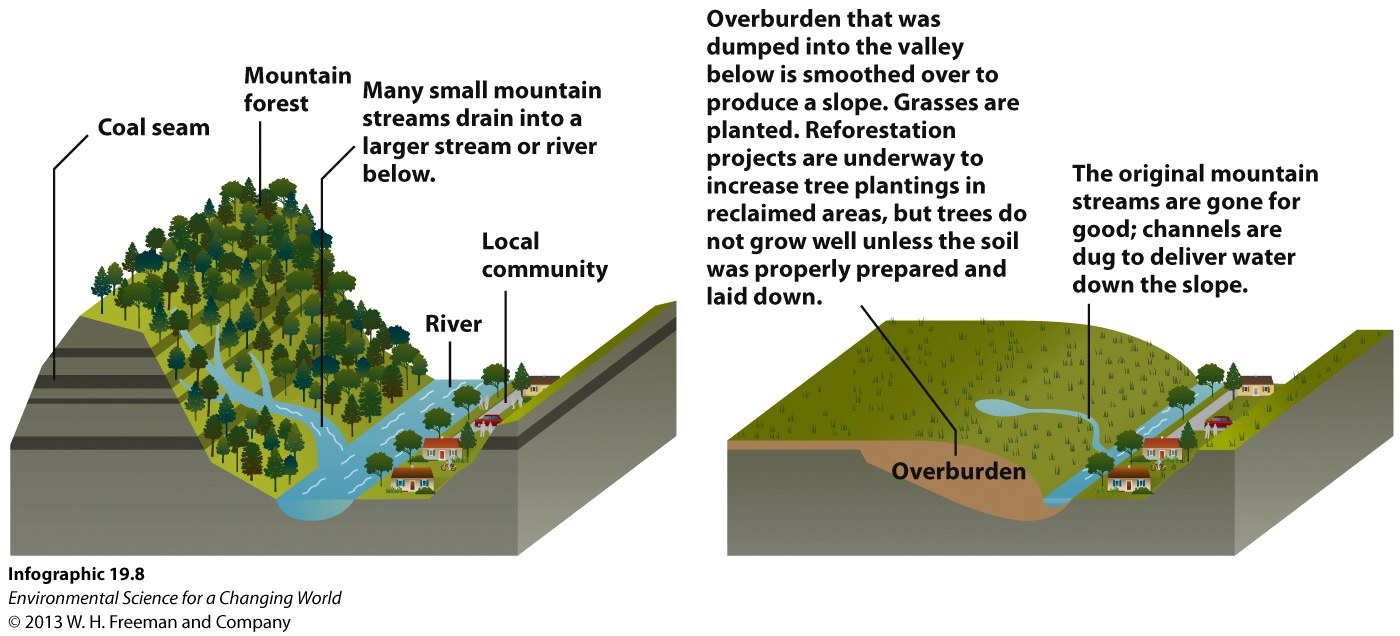
Chapter 19. Chapter 19: Coal
What new technologies allow us to mine and burn coal...?

Guiding Question 19.5
What new technologies allow us to mine and burn coal with fewer environmental and health problems?
Why You Should Care
It is difficult to imagine solving all of the drawbacks for coal, but at least some of them are being researched. Stopping mountaintop removal and returning damaged ecosystems to a healthier state minimizes the water pollution and ecosystem damage.
Cleaning up coal’s air pollution is receiving a lot of attention as well. Chief among the possibilities is the option of capturing and storing the carbon dioxide belowground. This will not create more coal or any other fossil fuel, but it will keep the carbon dioxide out of the atmosphere and minimize coal’s contribution to climate change.
Test Your Vocabulary
Fill in the blank with the correct term for each of the following definitions:
refers to restoring a damaged natural area to a less damaged state.
is a process that removes carbon from fuel combustion emissions or other sources and stores it to prevent its release into the atmosphere.
1.
What are the estimated external costs of coal mining and use?
| A. |
| B. |
| C. |
| D. |
2.
How does carbon capture sequestration (CCS) work?
| A. |
| B. |
| C. |
| D. |
3.
Which environmental problems does CCS stop?
| A. |
| B. |
| C. |
| D. |

4.
Reclamation:
| A. |
| B. |
| C. |
| D. |
5.
What are the ecological challenges of reclamation?
6.
Can reclaimed mine sites ever be claimed to be "as good as the original"?
Short-Answer Questions
Burning coal releases many heavy metals, including mercury, which has known health impacts. In the United States, coal combustion releases almost 50 tons of mercury (almost 50% of the total U.S. release). China releases up to four times as much mercury (between 100–200 tons) because it burns far more coal for its electrical needs.
Global wind patterns sweep some of that mercury across the Pacific Ocean. In the ocean, it precipitates and bioaccumulates (Chapter 14) in fish like tuna. A small amount of mercury makes it all the way to the United States, where it precipitates over the rainforests of the western United States.
China announced that it would be phasing in more stringent mercury controls for new and existing coal-fired power plants. These cuts would decrease emissions by 25%.
1) If Chinese emissions decreased by 25%, how many tons would be released?
2) Chinese coal-fired power plants are being built at a rapid rate, and production is increasing by 1% per year. How long would it take for the emissions to erase the new mercury controls?
3) No international treaties currently exist that regulate mercury release. If there was a treaty, what would it have to do?
2) If the rate is increasing at 1% per year (which is conservative; some estimates have China doubling in 10 years), then 25% is replaced in 25% divided by 1% = 25 years.
3) Any treaty would have to offset the production of mercury with the need for electricity from coal. Countries burn coal because they need the electricity to power their industries and homes today. The emissions from those power plants reach the atmosphere and are sent far away, sometimes landing in nearby countries or crossing oceans. It is very hard to identify airborne mercury’s source.
Activity results are being submitted...